With the flurry of Geforce 9600GT's hitting the
streets, there really are a lot of different videocards to consider. If you've
been pondering an upgrade, don't fret. Many of the new Geforce 9600GT's are
based on the reference videocard, and this makes it really simple to
comparison shop by price alone. A few models are pre-overclocked above the stock
GPU and memory clock speeds, while others are based on custom PCB designs that accommodate a physical HDMI port
at the back of the card. Of what's available, the choice basically boils down to
9600GT for
gaming, or a 9600GT that's a little better suited to for home theatre applications.
We think home theatre is going to play a very large role in many
consumers' computers, so don't underestimate it now.As to pre-overclocked or stock-clocked videocards...
well, the Geforce 9600GT
is pretty forgiving so I think both options are
equally valid. If you don't want to bother overclocking yourself, aim for a
pre-overclocked videocard like the Foxconn 9600GT-512NOC PCSTATS
is testing in this review. This baby is a single slot reference videocard which
has been pre-overclocked at the factory.
Foxconn's
9600GT-512NOC retails for about $195 CDN ($195USD, £118 GBP), and comes
with bare minimum. I think most consumers would agree that it's better to pay
less than have a couple bundled video games thrown in. As with the Palit
9600GT Sonic, Foxconn has pre-overclocked this Geforce 9600GT from the
stock clock speeds. The nVidia GPU runs an extra
50MHz quicker, the memory is up 100MHz, and the shader clock
runs 125MHz faster. There's a lot to like about a mainstream videocard like
the Geforce 9600GT, and it'll be interesting to see how much further we
can overclock this particular Foxconn card.
Foxconn's 9600GT-512NOC is equipped with 512MB of
GDDR3 memory, is DirectX10 and Shader Model 4.0 compliant, supports
nVidia SLI, and is PCI Express 2.0 and HDCP compliant. The maximum
supported output resolution through each of the two dualink DVI outputs is 2560x1600
pixels. A dongle cable facilitates connections with an external
display over Component Output/Composite/S-Video.
 |
|
Foxconn
9600GT-512NOC Videocard |
|
|
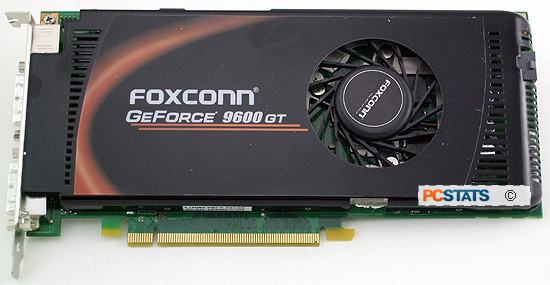
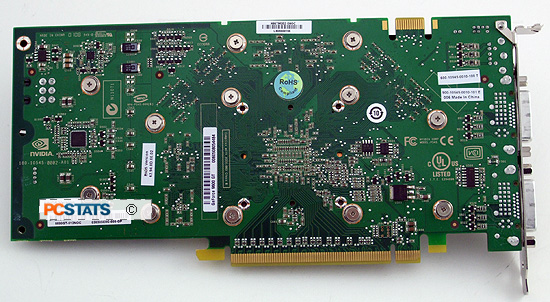
|
| Includes: |
|
User's Manual, Driver CD, Driveclone3,
(2) DVI to analog converters, SLI 6-pin power cable, component
output dongle cable. |
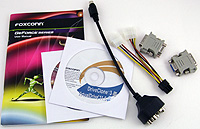 | | |
The
Foxconn 9600GT-512NOC videocard is based on the nVidia reference card layout and
uses the stock single-slot thermal solution. The reference heatsink is quiet
much of the time, but can become loud when the card is running stressful 3D
benchmarks. The card measures 22cm long and requires one 6-pin auxiliary power
connector.
The extra power connector is a big step up in power requirements for a mainstream-oriented videocard.
If your power supply lacks this connector you can use two molex plugs with the
included adaptor cable. At the top left hand corner of the videocard you'll see
the SLI bridge connector which allows you to run the Foxconn 9600GT-512NOC with
one other GeForce 9600GT videocard in SLI mode.
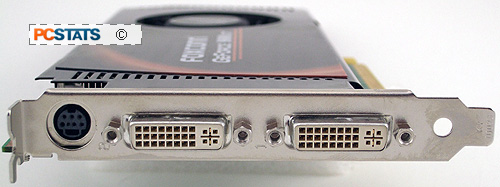
As with most mainstream
videocards, the accessory package is nothing to get
excited about. In the box you'll find two DVI-to-analog adaptors, a component output/s-video/composite video output dongle cable, and a molex-to-6pin power connector. The three video formats make
connecting one's PC to a big screen television an easy enough task. However,
like the Biostar Geforce 9600GT videocard PCSTATS recently
tested, the Foxconn 9600GT-512NOC also lacks a DVI-to-HDMI adaptor.
HDMI is much more convenient way of sending video
to a big screen, and the image quality is better too. It's surprising more
manufacturers are not including such a basic component with their Geforce
9600GT offerings. Curiously, the Foxconn 9600GT-512NOC ships with a copy of
DriveClone3 and VirtualDrive 11.5 software.
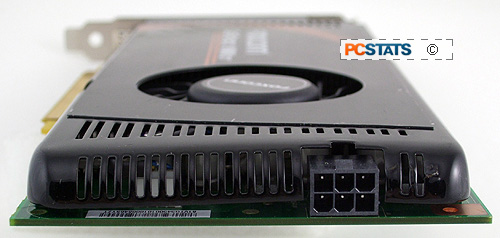
The
Foxconn 9600GT-512NOC videocard has a digital 2-pin audio header at the top
right corner next to the SLI connector. This is used to input audio to the
videocard, so it can output audio over an HDMI cable (if using a DVI-to-HDMI
adaptor). The appropriate motherboard SP/DIF audio jumper cable is not included.
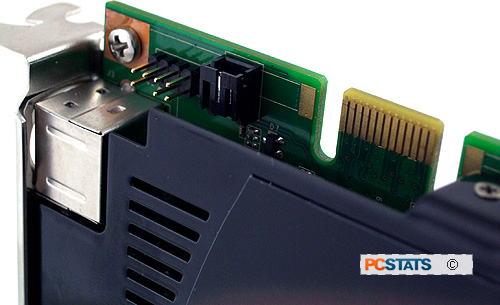
The
reason for this audio jumper is that nVidia's graphics cards do not incorporate
an audio codec. The audio signal needs to be connected to the videocard
manually, whereas ATI solutions have a built in codec so jumper cables are not
necessary. A quick look at the NVidia Geforce 9600GT core is next, and then
PCSTATS dives right into the overclocking!

